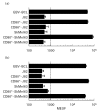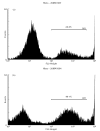Bladder cancer immunogenicity: expression of CD80 and CD86 is insufficient to allow primary CD4+ T cell activation in vitro
- PMID: 10209504
- PMCID: PMC1905215
- DOI: 10.1046/j.1365-2249.1999.00857.x
Bladder cancer immunogenicity: expression of CD80 and CD86 is insufficient to allow primary CD4+ T cell activation in vitro
Abstract
Transitional cell carcinomas (TCC) of the urinary bladder are known to express proteins which can yield potentially immunogenic peptide epitopes for expression in the context of cell surface class I or class II MHC antigens. However, additional costimulatory ligands must also be expressed before such a cell might directly induce full activation and proliferation of resting, antigen-specific T lymphocytes. Intravesical therapy might be used to manipulate T cell costimulation in order to promote specific rejection of TCC cells. This in vitro study examined the potential of such a strategy by transfection of the prototypical TCC line J82 with the important costimulatory molecules CD80 (B7-1) and CD86 (B7-2). Untransfected J82 cells expressed class I and II MHC antigens, a range of cell adhesion molecules, though did not induce T cell proliferation in a robust, allogeneic co-culture system. Transfected J82 cells expressed CD80 or CD86 at levels comparable to an antigen-presenting B cell line. Furthermore, functional surface expression of CD80 and CD86 was demonstrated in a mitogen-dependent assay of costimulation. However, neither CD80+ nor CD86+ transfectant J82 cells could induce significant proliferation of antigen-specific CD4+ T cells. Further analysis showed that bystander J82 cells could inhibit independent T cell activation in an effect dependent on direct cell contact. This inhibitory effect was associated with increased cell death in the responding lymphocyte population and is concordant with surface expression of CD95L by the J82 cell line.
Figures






Similar articles
-
Endothelial cells modify the costimulatory capacity of transmigrating leukocytes and promote CD28-mediated CD4(+) T cell alloactivation.J Exp Med. 1999 Aug 16;190(4):555-66. doi: 10.1084/jem.190.4.555. J Exp Med. 1999. PMID: 10449526 Free PMC article.
-
Functional expression of CD80 and CD86 allows immunogenicity of malignant B cells from non-Hodgkin's lymphomas.Exp Hematol. 1999 Mar;27(3):479-88. doi: 10.1016/s0301-472x(98)00059-9. Exp Hematol. 1999. PMID: 10089910
-
Differential expression and function of CD80 (B7-1) and CD86 (B7-2) on human peripheral blood monocytes.Immunology. 1996 Dec;89(4):592-8. doi: 10.1046/j.1365-2567.1996.d01-785.x. Immunology. 1996. PMID: 9014827 Free PMC article.
-
From the study of tumor cell immunogenicity to the generation of antitumor cytotoxic cells in non-Hodgkin's lymphomas.Leuk Lymphoma. 2000 Jul;38(3-4):247-63. doi: 10.3109/10428190009087016. Leuk Lymphoma. 2000. PMID: 10830732 Review.
-
Regulation of self-tolerance by CD80/CD86 interactions.Curr Opin Immunol. 1997 Dec;9(6):858-62. doi: 10.1016/s0952-7915(97)80190-2. Curr Opin Immunol. 1997. PMID: 9492990 Review.
Cited by
-
EGFR may participate in immune evasion through regulation of B7‑H5 expression in non‑small cell lung carcinoma.Mol Med Rep. 2018 Oct;18(4):3769-3779. doi: 10.3892/mmr.2018.9361. Epub 2018 Aug 8. Mol Med Rep. 2018. PMID: 30106102 Free PMC article.
-
Role of Adenoviruses in Cancer Therapy.Front Oncol. 2022 Jun 9;12:772659. doi: 10.3389/fonc.2022.772659. eCollection 2022. Front Oncol. 2022. PMID: 35756634 Free PMC article. Review.
-
System analysis of the regulation of the immune response by CD147 and FOXC1 in cancer cell lines.Oncotarget. 2018 Jan 11;9(16):12918-12931. doi: 10.18632/oncotarget.24161. eCollection 2018 Feb 27. Oncotarget. 2018. PMID: 29560120 Free PMC article.
-
Evolving immunotherapeutic strategies in bladder and renal cancer.Postgrad Med J. 2004 Jun;80(944):320-7. doi: 10.1136/pgmj.2003.013508. Postgrad Med J. 2004. PMID: 15192163 Free PMC article. Review.
-
CTLA-4 and PD-1 Ligand Gene Expression in Epithelial Thyroid Cancers.Int J Endocrinol. 2018 Jul 5;2018:1742951. doi: 10.1155/2018/1742951. eCollection 2018. Int J Endocrinol. 2018. PMID: 30123257 Free PMC article.
References
-
- Knight SC, Stagg AJ. Antigen presenting cell types. Curr Opin Immunol. 1993;5:374–82. - PubMed
-
- Lenschow DJ, Walunas TL, Bluestone JA. CD28/B7 system of T-cell costimulation. Ann Rev Immunol. 1996;14:233–58. - PubMed
-
- Hart I, Colaco C. Fusion induces tumour rejection. Nature. 1997;388:626–7. - PubMed
-
- Ostrand Rosenberg S. Tumor immunotherapy—the tumor cell as an antigen presenting cell. Curr Opin Immunol. 1994;6:722–7. - PubMed
Publication types
MeSH terms
Substances
LinkOut - more resources
Full Text Sources
Medical
Research Materials

